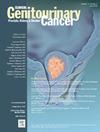BMI分类对非肌性浸润性膀胱癌复发进展预后的影响。
IF 2.3
3区 医学
Q3 ONCOLOGY
引用次数: 0
摘要
目的:评估超重或肥胖与非肌肉浸润性膀胱癌(NMIBC)复发、分期进展和分级进展的关系。方法:纳入NMIBC患者,根据体重指数(BMI)分为正常体重、超重和肥胖3组。复发被定义为任何经尿道膀胱肿瘤切除术(turt)后组织学证实的膀胱癌。进展被定义为从低级别升级到高级别,从pTa升级到pT1,或从pT1疾病升级到肌肉侵袭。结果:共分析457例患者,体重正常135例(29.5%),超重192例(42.6%),肥胖130例(28.4%),BMI中位数为27.1 (24.4-30.7)Kg/m2。研究发现,在BMI分类中,复发时间、分期进展和分级进展无显著差异(P < 0.05)。此外,BMI类别未观察到风险增加(肥胖复发HR: 1.067, CI 95%: 0.783-1.453;肥胖分期进展HR: 1.315, 95% CI: 0.635-2.724;肥胖等级进展HR: 0.586, 95% CI: 0.195-1.760)。结论:在我们的队列中,体重类别显示与NMIBC复发、分期进展或分级进展无关。这些发现强调需要识别其他可能改善NMIBC风险分层的潜在危险因素。需要进一步的研究来验证我们的结果,并探索NMIBC结果的其他预测因素。本文章由计算机程序翻译,如有差异,请以英文原文为准。
Impact of BMI Category on Recurrence and Progression of Nonmuscle Invasive Bladder Cancer Prognosis
Objective
To assess the association of being overweight or obese with Nonmuscle invasive bladder cancer (NMIBC) recurrence, stage progression, and grade progression.
Methods
Patients with NMIBC were included and categorized into 3 groups based on their body mass index (BMI): normal weight, overweight, and obese. Recurrence was defined as any histologically proven bladder cancer on subsequent transurethral resection of bladder tumor (TURBT). Progression was defined as upgrading from low to high grade, upstaging to pT1 from pTa, or to muscle-invasion from pT1 disease.
Results
A total of 457 patients were analyzed, 135 (29.5%) had normal weight, 192 (42.6%) were overweight, and 130 (28.4%) were obese, with a median BMI of 27.1 (24.4-30.7) Kg/m2. The study found no significant difference in the time to recurrence, stage progression, and grade progression within the BMI categories (P < .05). Additionally, no increased risk was observed in BMI categories (Obesity recurrence HR: 1.067, CI 95%: 0.783-1.453; Obesity stage progression HR: 1.315, 95% CI: 0.635-2.724; Obesity grade progression HR: 0.586, 95% CI: 0.195-1.760).
Conclusions
In our cohort, body weight category showed no association with NMIBC recurrence, stage progression, or grade progression. These findings highlight the need to identify other potential risk factors that could improve NMIBC risk stratification. Further studies are warranted to validate our results and explore additional predictors of NMIBC outcomes.
求助全文
通过发布文献求助,成功后即可免费获取论文全文。
去求助
来源期刊

Clinical genitourinary cancer
医学-泌尿学与肾脏学
CiteScore
5.20
自引率
6.20%
发文量
201
审稿时长
54 days
期刊介绍:
Clinical Genitourinary Cancer is a peer-reviewed journal that publishes original articles describing various aspects of clinical and translational research in genitourinary cancers. Clinical Genitourinary Cancer is devoted to articles on detection, diagnosis, prevention, and treatment of genitourinary cancers. The main emphasis is on recent scientific developments in all areas related to genitourinary malignancies. Specific areas of interest include clinical research and mechanistic approaches; drug sensitivity and resistance; gene and antisense therapy; pathology, markers, and prognostic indicators; chemoprevention strategies; multimodality therapy; and integration of various approaches.
 求助内容:
求助内容: 应助结果提醒方式:
应助结果提醒方式:


